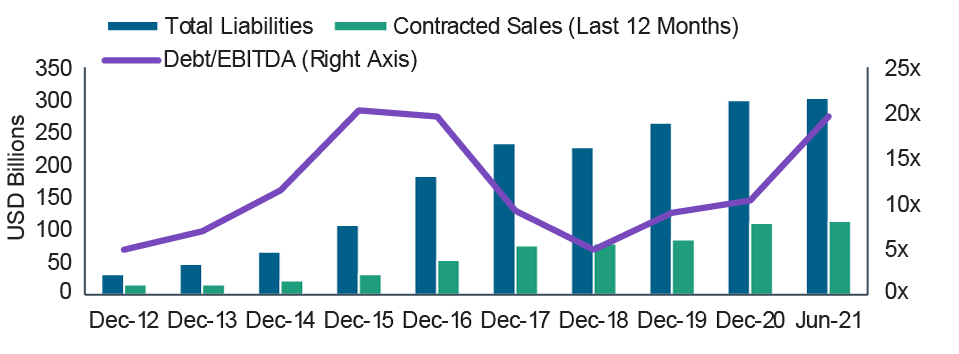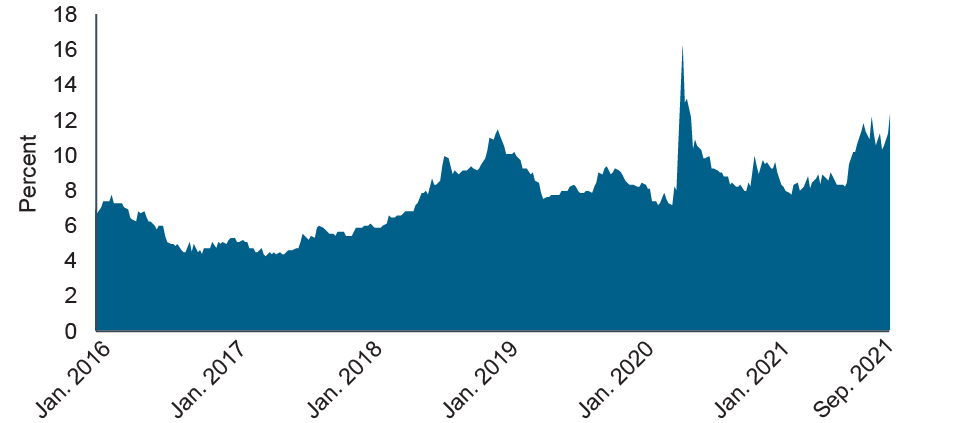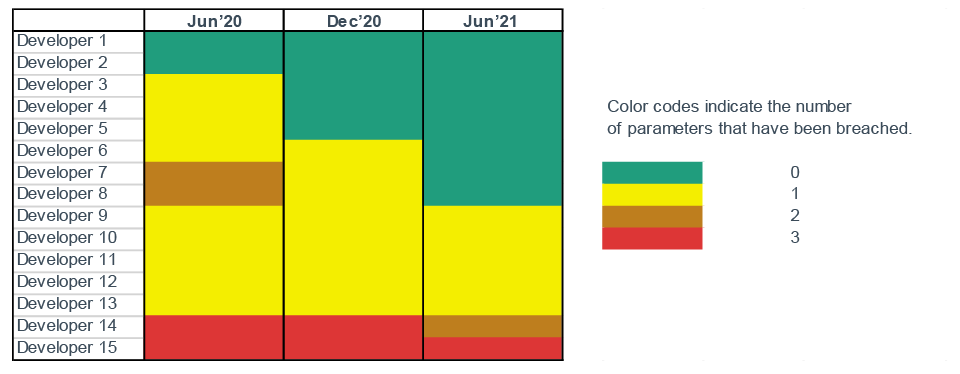October 2021 / INVESTMENT INSIGHTS
Controlled Deflation of the China Property Debt Balloon
Beijing’s policy actions in the property sector seem to be containing any potential contagion effect
Key Insights
- We are confident that there will be a well‑managed deflation of the debt balloon in the real estate sector and that Evergrande’s troubles are unlikely to cause systemic risk.
- As the government looks to carefully manage economic and social impacts, we do not anticipate policy action in the real estate sector to amplify further.
- Volatility in the markets may present attractive entry points to add exposure to the sector.
What Is Happening With Evergrande?
Evergrande is the second‑largest property developer in China by contracted sales (USD 111 billion in 2020). It has a 5% market share in the sector, which, together with the supply chain, composes over a quarter of economic activity in China. The company has undergone aggressive debt‑funded growth in the past few years as the sector grew rapidly, with urbanization remaining a focus in Beijing’s five‑year plans. As of June 2021, Evergrande had a total liability of more than USD 300 billion, almost triple what it had at the end of 2015.
China Evergrande’s Key Debt Metrics
(Fig. 1) Debt and liabilities have risen over the years

As of June 30, 2021.
For illustrative purposes only. EBITDA = Earnings Before Interest, Taxes, Depreciation and Amortization. This information is not intended to reflect a current or past recommendation concerning investments, investment strategies, or account types, advice of any kind, or a solicitation of an offer to buy or sell any securities or investment services.
Source: Data from China Evergrande Group.
Over the past few months, Evergrande’s financial situation has worsened. To avoid a disorderly default and contain the impact, Chinese regulators have moved to centralize all lawsuits against the company at the Guangzhou Intermediate Court.
USD High Yield China Real Estate Bond Yields Have Risen
(Fig. 2) Offshore investors turn cautious as financing channels narrow

As of September 17, 2021.
Past performance is not a reliable indicator of future performance.
Sources: Bloomberg Finance L.P./J.P. Morgan Chase (see Additional Disclosure), analysis by T. Rowe Price.
Policy Backdrop: Spread Widening
China real estate credit spreads have widened since the government started to tighten policies for the sector last year, with measures such as the introduction of the “three red lines” for developers and “two red lines” for banks.
The three red lines policy dictates the cash to short‑term debt, liability to asset (excluding contract liability), and net gearing ratios that property companies must achieve by 2023. It signals Beijing’s intent to inject greater discipline into the sector. Similarly, the two red lines policy for banks is aimed at capping mortgage lending and overall property‑related loans. While the intention is to ensure the long‑term healthy development of the property sector, banks have been prudently reviewing their lending to the sector, which has contributed to tighter onshore financing channels for developers.
The three red lines policy has been particularly effective in curbing some of the more aggressive growth strategies among the developers. Year to date, the industry has become more prudent with land banking activity (acquiring land for future development), with average land purchases declining to 24% of contracted sales in 1H21 from 39% in 2019 (and 34% in 2020). We have started to see improvements across the board since the three red lines policy was first unveiled, with several names in a list of China’s leading developers performing better on key metrics tracked by policymakers. (See Fig 3.)
The Implications of Government Policy Action
We do not believe that a default by Evergrande will cause systemic risk in China’s credit markets.
We believe that there will be a well‑managed deflation of the debt balloon and that the current turbulence is unlikely to pose a test of financial stability in China. Although one of the larger developers, Evergrande accounts for a small amount of total sales in a fragmented industry. We expect that any impact to the banking system will be manageable and that the government will instead focus on the social fallout of unfinished housing units, followed by property supply chain suppliers exposed to Evergrande payables. Evergrande’s offshore USD bonds are currently trading at around 20‑30 cents on the dollar,1 but this reflects their lower ranking in claims. We expect onshore debt and liabilities will have priority in any debt restructuring process, and regulators are watching these closely to help ensure an orderly process.
Policy Impact on Selected Major China Property Developers
(Fig. 3) Fewer breaches of government‑tracked metrics over time

As of June 30, 2021.
For illustrative purposes only.
Source: Data from individual companies.
Policymakers will also be mindful of the potential social and economic impact. It is worth remembering that the implementation of policies in the property sector historically moves in cycles, starting with actions that initially lead to negative market reactions and hits to confidence, followed by efforts to stabilize sentiment.
Policy toward the real estate sector is unlikely to be amplified further.
Physical market indicators such as average sales price, land sales, and new housing starts have all moderated recently, indicating some degree of policy success. China’s National Bureau of Statistics recently commented that the property curbs have contained unreasonable demand while at the same time warned that contagion impacts on the real estate industry need to be monitored closely. Our view is consistent with our conversations with management teams of the larger developers as well as industry consultants, where it is generally believed that we have seen the peak of policy tightening.
That said, we do not expect any material loosening of property policy in the near term. As part of the government’s strategy to structurally reduce risk in the broader financial system, the three red lines and two red lines policies were introduced as multiyear initiatives that are due to be “tested” in 2023 and 2024.
We expect the Asia high yield market to continue to differentiate among the different developers.
Under the three red lines, the trend of consolidation and divergence will likely continue. In 2016–2018, mainly large developers gained market share. The top 50 developers’ market share collectively grew from 36% in 2016 to 51% in 2018, remaining largely stable since. As regulators are determined to achieve their policy goals, developers with stronger execution and financial management should gain market share, with more stressed players exiting the market. Regardless of the overall monetary policy of China, funding available to the residential property sector will be closely controlled. Those that are unable to meet the three red lines requirement will suffer the most in a tight funding environment. Therefore, more defaults are possible in the near future.
Impact on Investment Approach
We remain constructive on the long‑term investment opportunities within the Chinese high yield real estate sector. The implementation of policies targeted at curbing property developers’ leverage should ultimately lead to a healthier sector backdrop and more sustainable balance sheets.
Evergrande’s offshore USD bonds account for 5% of the Asia USD high yield universe.2 A period of elevated high yield default rates may lead to USD market access being shut for weaker issuers. Not all developers will get through this period of tighter funding easily. We would not rule out the potential for more companies to come under stress with further credit defaults. This may keep volatility elevated for the China high yield market and present attractive entry points to add exposure to the sector.
However, we do not expect fundamentally sound issuers to face sustained credit stress, and we expect contagion to broader Asian or global credit markets to remain contained. We believe that the diverging nature of the sector means that a fundamentally driven, bottom‑up investment process is crucial in seeking to identify the best ideas to generate alpha for portfolios.
IMPORTANT INFORMATION
This material is being furnished for general informational and/or marketing purposes only. The material does not constitute or undertake to give advice of any nature, including fiduciary investment advice, nor is it intended to serve as the primary basis for an investment decision. Prospective investors are recommended to seek independent legal, financial and tax advice before making any investment decision. T. Rowe Price group of companies including T. Rowe Price Associates, Inc. and/or its affiliates receive revenue from T. Rowe Price investment products and services. Past performance is not a reliable indicator of future performance. The value of an investment and any income from it can go down as well as up. Investors may get back less than the amount invested.
The material does not constitute a distribution, an offer, an invitation, a personal or general recommendation or solicitation to sell or buy any securities in any jurisdiction or to conduct any particular investment activity. The material has not been reviewed by any regulatory authority in any jurisdiction.
Information and opinions presented have been obtained or derived from sources believed to be reliable and current; however, we cannot guarantee the sources’ accuracy or completeness. There is no guarantee that any forecasts made will come to pass. The views contained herein are as of the date noted on the material and are subject to change without notice; these views may differ from those of other T. Rowe Price group companies and/or associates. Under no circumstances should the material, in whole or in part, be copied or redistributed without consent from T. Rowe Price.
The material is not intended for use by persons in jurisdictions which prohibit or restrict the distribution of the material and in certain countries the material is provided upon specific request. It is not intended for distribution to retail investors in any jurisdiction.
October 2021 / ENVIRONMENTAL, SOCIAL, AND GOVERNANCE
October 2021 / INVESTMENT INSIGHTS
